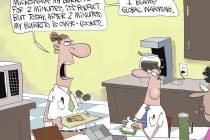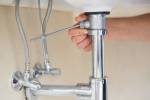EDITORIAL: Public school improvements that won’t bust budget
If money alone could really solve all the problems in K-12 education, students in Nevada and nationwide would be among the best and brightest in the world. But as reported last week by the Review-Journal’s Whip Villarreal, an extensive study by the Nevada Policy Research Institute showed that cash isn’t king, while also making 33 recommendations that could improve public education in the Silver State without further hitting taxpayers.
The NPRI study notes that the typical American high school graduate in 1970 was supported by $56,903 in taxpayer funds, when adjusted for inflation to 2013 dollars. By 2010, that amount had grown to a whopping $164,426 — nearly three times as much, yet with no significant gains in skills or knowledge, as measured by the National Assessment of Educational Progress, a standardized federal test. In Nevada, per-pupil spending nearly doubled (again, adjusting for inflation) between 1972 and 2012. But over that same period, the state’s adjusted SAT scores basically flat-lined, indicating students were slightly less prepared for college by 2012.
The long-standing liberal argument that more money makes better schools has been disproved. Yet money is the entire basis for Question 3 on the November ballot — the Education Initiative, often referred to as the margins tax. The tax would suck as much as $750 million annually out of the economy from Nevada businesses, in ways that could potentially put some of those companies out of business or force major cutbacks, while providing no accountability for how or where the money would be spent.
The Clark County School District would greatly benefit from additional funding for programs that work and are directly tied to student achievement. And in fact, we have come out in favor of more funding in this space, provided that it’s in concert with education reforms and money-saving public sector and collective bargaining reforms. The NPRI study promotes many such reforms that could be instituted within the current budget.
Some of the recommendations:
■ A merit pay system for the top 10 percent of teachers. On the opposite end of the spectrum, NPRI advocates removing the bottom 5 percent of educators as equally important to improving student outcomes.
■ Reduction-in-force decisions based on effectiveness. In other words, keep the best teachers in the classrooms, regardless of seniority.
■ Redirect class-size reduction funding and full-day kindergarten funding. The NPRI study stated that taxpayers will pony up more than $500 million in the 2013-15 budget cycle for these two programs, but scholars from across the political spectrum agree the programs are not cost-effective and don’t correlate to long term achievement.
■ Stop paying prevailing wages for school construction. Among the largest expenses for schools — and among the most necessary right now in Clark County — are construction and maintenance. State regulations requiring union wages on all public school construction projects significantly inflate the cost. NPRI said Nevada could learn from Ohio, whose legislators in 1997 exempted public schools from the prevailing wage law, shaving 10 percent off costs in just the first five years — $487.9 million in savings. A similar step in Nevada for the 2009-10 and 2010-11 school years would have saved the state $72.6 million.
Again, there is no denying that CCSD needs additional funding, but the margins tax is not the way to get it. And until such time that major additional education expenditures are tied much more directly to student achievement and cost-effective reforms, the NPRI study highlights many things we can do right now — without spending any more money.























